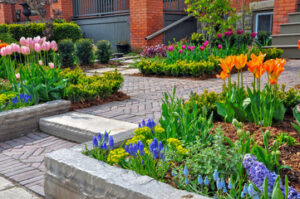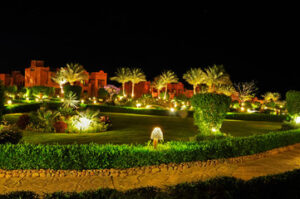Landscaping is the practice of adding plants and modifying terrain for aesthetic purposes. It can also involve the design of gardens and the construction of structures. It includes basic design principles such as balance, proportion, and unity.

Color plays an important role in landscape design. Using contrasting shades creates visual interest, while using similar hues helps elements to blend together. Visit https://www.primecutlawnky.com/ to learn more.
Landscaping is the art of designing, organizing and enriching outdoor spaces for aesthetic and practical purposes. It involves planting trees, shrubs, flowers and other plants. It also includes creating and maintaining garden beds, ponds, and other outdoor features. Landscapers often work with a variety of materials to create unique and beautiful designs.
One of the most important aspects of landscaping is creating balance and order in a garden or outdoor space. The balance can be formal (symmetrical) or informal (asymmetrical). The use of shapes, lines, colors and textures helps to achieve this balance. Another key aspect of landscape design is repetition, which can be used to create visual harmony and unity. This can be done by lining up similar objects in a row, or using geometrical shapes such as squares. Repetition can be used to emphasize the focal point of a design, or to add depth and interest.
Besides adding beauty and value to your home, landscaping can also improve your mental health. Studies show that being surrounded by greenery can help reduce stress levels and encourage physical activity. Additionally, landscaped yards and gardens provide a peaceful retreat where homeowners can relax and unwind. It can even increase property value, as potential buyers may be more willing to pay for a well-maintained garden.
Another benefit of gardening and landscaping is that it can be a fun hobby for people of all ages. It can be as simple as planting a flower or shrub in your backyard, or more complicated, like creating a garden with a trellis for vines to climb. The best part about gardening is that it can be done by anyone, and there are plenty of resources available to get started.
When choosing a landscape, it is important to consider the needs of your space and budget. For example, a public garden will have different requirements than a residential garden. You can also choose from a number of different styles and themes, such as Zen gardens, Mediterranean gardens, or English gardens. These will give your garden a specific personality that complements your home’s style.
It involves the design of gardens
Landscapers design gardens and other outdoor spaces for aesthetic and practical purposes. They may also install structures like patios, walkways and retaining walls. They can also create water features, such as ponds and fountains. Unlike gardening, which is usually done by amateur gardeners, landscaping requires professional equipment and expertise. The best landscapers can work with you to create a design that will fit your needs and budget.
The first step in the process of designing your own landscape is to establish a theme. The theme should reflect the type of atmosphere you want in your yard and complement the architecture of your home or business. It should also be aesthetically pleasing and reflect your personality.
Once you have a theme, it’s time to consider the layout of your property. There are several different elements that go into a successful design, including transition, contrast and focalization. Transition refers to creating a gradual change between one area and another. It can be achieved by varying the size, color, or shape of design elements. It is also possible to use different textures to add visual interest to a landscape.
Contrast is used to highlight certain elements in a landscape. This can be accomplished by contrasting colors, plant sizes and shapes, or leaf textures. Using these elements can draw the viewer’s attention to specific parts of the landscape and help it look more cohesive. It is important to avoid repetition, however, as this can create a monotony that will detract from the beauty of your landscape.
In addition to these elements, a successful landscape should include a variety of plants that will bloom throughout the year. This will make your landscape look attractive all seasons. It’s also important to consider the effect that the changing sun and weather will have on your landscape.
Landscaping can be a fun and rewarding activity, especially for those with a passion for nature. It is also a way to improve the appearance of a property, increase its value and create an inviting atmosphere. A well-designed landscape can also improve a person’s mood and mental health by releasing endorphins, the body’s natural feel-good chemicals.
It involves the installation of hardscapes
Landscaping involves the installation of hardscapes, which are non-living materials like pavers, rocks, bricks, wood and concrete. These materials are used to create features such as patios, walkways, seating areas, fire pits and retaining walls. A landscaper is a professional who works with these materials, and can help you design your outdoor space to suit your needs and taste. They can also offer advice on how to maintain your garden or landscaping after it’s been installed.
Hardscapes can add texture, contrast and movement to your yard. They can also create a focal point for your design. The elements of a good hardscape are scale, line and form, which should be balanced with varying textures and colors. The balance of these elements is what gives a landscape its appeal and makes it a place you’ll want to spend time in.
In addition to enhancing the aesthetics of your home, hardscapes can also increase the value of your property. Many people are drawn to homes that have both beautiful landscaping and functional hardscapes, and they’re more likely to make an offer on a property that looks well cared for. In addition, hardscapes and landscaping can help to reduce greenhouse gas emissions and provide habitat for wildlife.
When incorporating hardscapes into your landscape, it is important to consider how they will affect the drainage of your garden. For example, if your garden has a steep slope, retaining walls will prevent the soft muddy soil from becoming too sloping and damaging your garden’s structural integrity. In addition, retaining walls and stone steps will prevent erosion and keep your yard looking clean.
Another important consideration when creating a hardscape is to use curves and rounded lines rather than straight ones. Too many straight lines can make a landscape look unnatural and boring. However, using curves and rounded lines in your hardscapes will make them more appealing to the eye.
The right hardscape can greatly enhance your garden and make it a great place to relax and enjoy your backyard. There are a variety of different ways to incorporate hardscapes into your landscape, including terrace gardens, rooftop gardens, pergolas and raised beds. You can even install a water feature such as a fountain or an ornamental fish pond in your backyard.
It involves the maintenance of gardens
Landscape maintenance is a series of services that keeps your garden healthy and beautiful. It includes pruning, mowing, mulching, and trimming of trees and shrubs. It also involves weed control and pest management. Regular maintenance of your yard will help keep the soil fertile and healthy, and it will prevent weeds from taking over your garden. Irrigation systems are another aspect of landscape maintenance, and they need to be properly maintained to ensure that they operate efficiently. It is important to use a professional company for landscaping maintenance, because they have the expertise to manage these tasks effectively and efficiently.
Landscaping differs from gardening in that it incorporates non-living elements such as fountains and ponds into the design of gardens and outdoor spaces. It is also more professional than gardening and is practiced by paid designers and architects. It also incorporates hardscape features such as sidewalks, chairs, and water features into the layout of a garden.
Besides the aesthetic benefits of a well-maintained yard, it can have health and wellbeing benefits for homeowners. It can lower stress levels, reduce anxiety and depression, and increase the amount of time spent outdoors. It also improves air quality by absorbing carbon dioxide and other pollutants and releasing oxygen. It can also prevent erosion by retaining soil and stabilizing slopes.
A landscaped garden can increase the resale value of your home, but it’s important to decide whether you’ll be staying in your current property for a long period of time or will sell it eventually. This will help determine the scale of your investment and the complexity of the landscaping. Ideally, you should choose a landscape style that complements your property and suits the lifestyle requirements of your family.
Choosing the right plants is essential for a successful landscaping project. Different species have a range of climates they are best suited to, and some may not thrive in your climate at all. A good landscaper will know which plants are suitable for your location and will take into account factors like temperature, rainfall, and sunlight. They will also recommend appropriate soil conditions, mulching and fertilizers for your garden.
